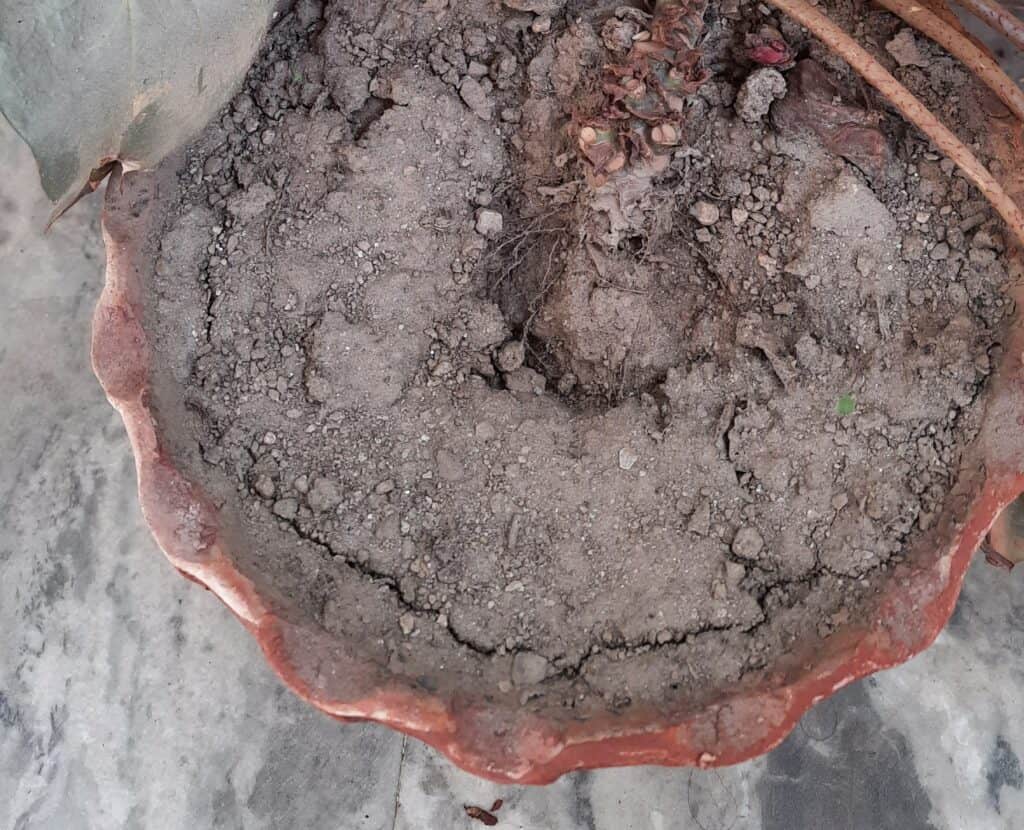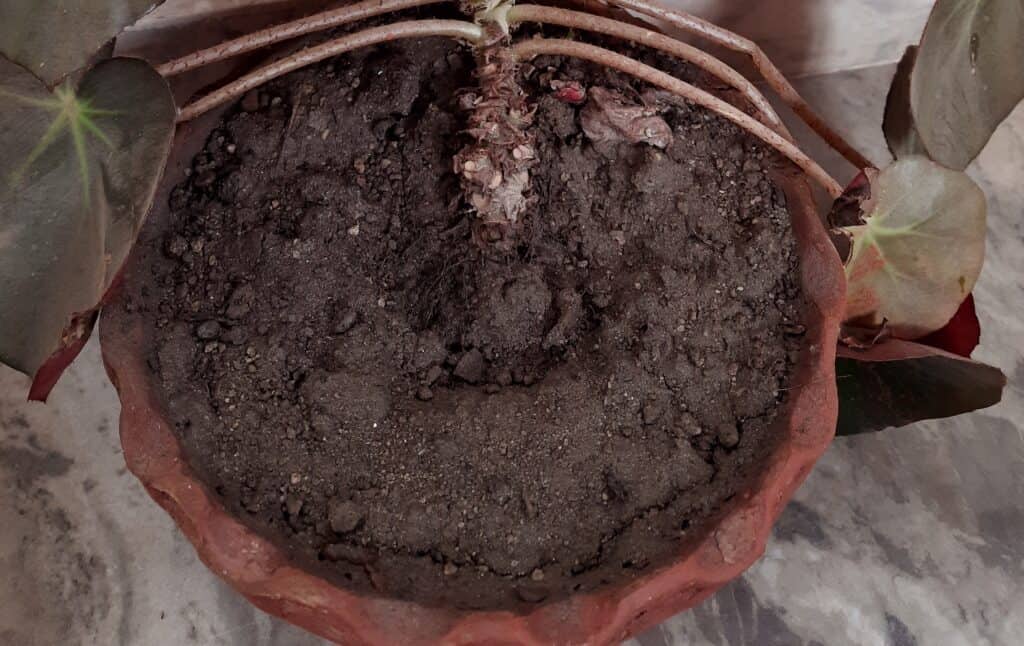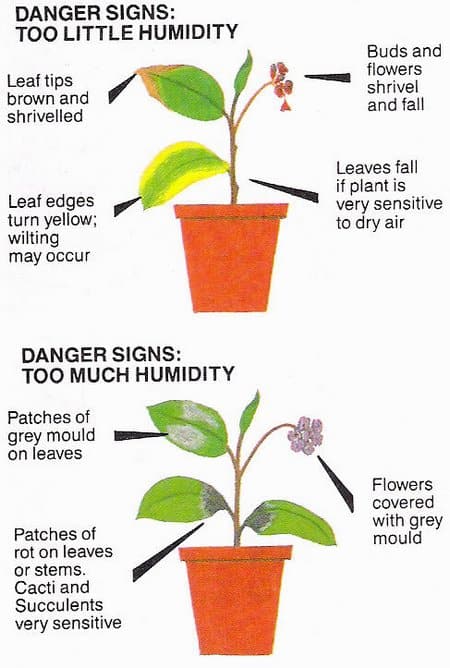You just got a beautiful umbrella plant that goes right by your living space. Isn’t it a total buzzkill if your green Schefflera leaves start going brown?
You may keep your Schefflera in front of a window that receives enough filtered sunlight and try to do everything right.
But if only one thing is missed, your umbrella plant will give you a fair share of trouble!
The most common causes of brown and crispy leaves in Schefflera are overwatering and frequent temperatures change. Excessive Bright Light and Over-Fertilization could also be contributing factors. Other less typical reasons to be on the alert include low humidity, an infestation of diseases, and pests.

Here is a discussion on the possible reasons your Schefflera leaves turn brown and crispy with every possible solution.
Table of Contents
Is it Normal for Schefflera Leaves to Get Brown and Crispy?
When you see the tips, edges, or the whole leaf of any houseplant go brown or yellow, your first thought should be, and will be, what am I doing wrong?
Unless the cause is natural aging, it is not normal for Schefflera leaves to get brown and crispy.
Schefflera shades the bottom leaves as a sign of natural aging and gives newborn leaves more growth.
You can prune off the brown leaves and help the new growth.
If the cause of brown and crispy leaves is not a natural phenomenon, you need to identify the underlying cause and work on it.
Schefflera Leaves Turning Brown and Crispy [Possible Causes With Solutions]
The first reason your Schefflera leaves turn brown and crispy is the watering schedule. If you balance the watering, your Schefflera can do fine in its life.
The water is chemical-free, and you are watering your plant right.
Your Schefflera goes brown and crispy from the tips and edges. It would be best to look into the following factors one by one.

Without further ado, let’s have a quick outlook on what can cause your Schefflera leaves to be brown and crispy.
| Causes | Solutions |
|---|---|
| Very Dry Soil | 1. Water in a routine 2. Do not use excessively draining soil |
| Drainage Issues | 1. Use a pot with drainage holes 2. Check the blockage 3. Do not overwater |
| Low Humidity | Maintain the humidity between 60 and 75 % |
| Temperature Change | Maintain the temperature between 65 and 90°Farenheit |
| Diseases | Clean the leaves and use antifungal/antibacterial sprays |
| Chemical Sensitivity | 1. Use filtered or salts free water 2. Use rain water |
| Excess of Fertilizer | Fertilize once in a month only in growing season |
Now, let’s go through the causes and solutions for your Schefflera leaves to go brown and crispy.
1. Underwatering Schefflera
Your Schefflera prefers a thorough watering when the top 30% to 50% of the soil is dry. If you do not water it in a week or two, the soil will go dry.
Be sure you give your plant a drink as per its need.
Dry soil causes Schefflera leaves to dry out. Prolonged underwatering leads to brown and crispy leaves.

As shown in the figure, if the soil is extremely dry, you need to give your Schefflera a good soak.
Your Schefflera’s leaves may be going brown and crisping up due to dry soil and lack of required moisture in roots and the plant’s body.
Solutions
- When watering, run the water until it runs down the drainage holes so that the roots are well soaked.
- Lift the pot every day to track the weight change. If it feels relatively lighter, the soil is dry, and you need to water the plant.
- Insert your finger up to 2 inches in the soil, and if the soil is dry, it’s time you give your Schefflera a good soak.
- Check on your potting mix because too well-draining soil can dry up fast. Use the proper potting mix to solve this issue.
- For a severely underwatered Schefflera, fill a sink with water and give your plant a good soak of one hour. I would suggest you use filtered room temperature water.
Know how water quality affects Stromanthe leaves to go brown.
2. Drainage Issue
When water cannot drain away from the soil, it becomes waterlogged, causing your plant’s drainage problems.
Overwatering causes waterlogging, which is frequent in thick compact soil. Moist soil and yellow leaves are the first indicators of drainage problems.
Dark spots on the mid-leaf may emerge, and the tips may begin to go brown.
Too much water leads to root decay, and thus its leaves start turning dark, mushy, and eventually fall off.
The dead and decaying roots won’t be able to supply enough water and nutrients to the shoot system. Hence, the healthy leaves eventually droop, turn brown, and fall off altogether.

Solutions
- Use proper terracotta or clay pot with 2-3 drainage holes.
- Locate the plant in a spot that gets plenty of bright indirect sunshine to dry up the soggy soil.
- Water your Schefflera twice a week in summer and spring and once a week in the fall and winter, depending on the requirements.
- Examine the aeration of the soil. To aid aeration, make holes in the soil using a stick or pencil.
- For proper water drainage, use a well-draining potting mix.
Pro Tip: To guarantee proper airflow and reduce water retention, an ideal potting mixture should include perlite, peat moss along with sand or some pebbles at the bottom.
- Examine the root system along with the brown tips and leaves. Trim them carefully to prevent further damage to your Schefflera if they’ve started to rot.
- If the damage is severe, you can re-pot your plant in a fresh potting mix.
3. Low Humidity
When we turn on the air conditioner (hot or cold), the humidity in the room plummets.
The shift in humidity levels between 60 and 75 % is suitable for your Schefflera plant.
However, if the humidity lowers from 60%, your plant will show you symptoms.
Lack of moisture leads to leaf drying, and the leaf tip is the last part of the plant to receive water through transportation as the water and nutrients flow from the roots to the leaf tip.
Additionally, the tip of the Schefflera begins to turn brown, and the leaves become crispy.

Solutions
- Use an electric humidifier to ensure the optimum humidity level for your Schefflera.
- Move your plant to a high humid region in your house. Usually, bathrooms and kitchens have relatively higher humidity so that you can move your plants in case the humidity drops.
- You can create a mini biosphere for your plants by grouping different houseplants. Plant’s transpiration increases humidity.
- Take some pebbles in a tray and add some water to it. Place the Schefflera pot on it, and you have your pebble tray.
- Spray the plant leaves with water to boost humidity during the low humidity season. However, dripping leaves invites fungus and bacterial diseases.
- You can place your Schefflera and other plants in a terrarium. Humidity is maintained in an enclosed glass container.
- Avoid keeping your Schefflera near the air conditioner or the window that receives cold winter winds.

4. Temperature Extremities
As you already know, cold drafts in winters lower the temperature for your Schefllera.
The optimum temperature for Schefflera is between 65 and 90°Farenheit.
The low temperature might cause plant enzyme activity to get reduced.
Because plants produce enzymes to breakdown surrounding elements for soil, this disturbs plant nutrition uptake.
Plant nutrition intake is disrupted because plants produce enzymes to break down surrounding components for soil. As a result, they may grow slowly or die in the worst-case scenario.

Although Schefflera can tolerate a little higher temperature and won’t die on you, however, excessive heat can burn their leaves brown.
Some houseplants can do well outdoor and tolerate direct sunlight. However, it’s not the same case with Schefflera.
Solutions
- Do not place it near the south-facing window where it receives excessive heat.
- Keep the plant away from electric heaters, heating radiators, and air conditioners.
- Bring your outdoor Schefflera inside during hot summer and cold winter.
- Move the plant away from cold and windy areas in winter.
- A thick layer called mulch is used to cover the plant in the cold. You can lock the temperature for your Schefflera.
- Place your plant near a double-glazed window to ensure it gets enough light.
- Alternatively, a frost blanket can shield the plant from cold stress.
- As the temperature increases above 90°F, check the soil for dryness and increase the watering frequency.
- In chilly weather, use heating pads to warm the soil for young plants.
5. Infestation of Pests and Diseases
Brown leaves on the Schefflera can be caused by fungal and bacterial illnesses.
If your Schefflera leaves have brown spots and a yellow ring-like structure around the brown spot, it’s a bacterial infection.

Keeping the plant in a higher humidity area makes it vulnerable to pests. Damp leaves invite bacteria and fungi.
Here are two common pathogens causing disease in Schefflera.
1. Alternaria panax
Alternaria panax causes Alternaria Leaf Spots in Schefflera. You can see dark spots all over the leaves. Yellow rings usually cover the dark areas.
2. Xanthomonas campestris
When you notice yellow spots on the lower leaves of Schefflera that are gradually turning brown, then your plant is affected by Xanthomonas campestris. It is also identified as a bacterial spot.
To reduce fungal and bacterial growth, ensure your room has adequate air circulation.
You do not want them to thrive with high humidity and little air movement. There are different ways to treat your infected plants!
Treatment for Diseases
- Alternaria Leaf Spot can be treated with fungicides containing chlorothalonil, fludioxonil, imazalil, iprodine, maneb, mancozeb, or thiram.
- Copper-based plant protection solutions can be beneficial since they have bactericidal activity (kill microorganisms).
- There are also disinfectants that contain hydrogen peroxide or quaternary ammonia for bacterial leaf spots.
Sad Note: There are no effective bactericides that can be used to tackle the pathogen.
Preventive Measures
- Avoid too much water, soggy soil, and frequent misting.
- Before potting it, make sure your Schefflera plant is in aphid- and pest-free gardening soil.
- If you are a plant grouping person, distinguish the pest-free plants from the pest-infested ones.
- Leaf cleaning can be aided by wiping or just wetting Schefflera leaves and allowing the leaves to dry in bright indirect sunlight.
- Wipe off the pests with ethanol.
- Wash, the entire Schefflera, leaves with insecticidal soap or Neem oil once.
6. Chemical Sensitivity
Houseplants are sensitive to chemicals present in the water. Likewise, chemicals build-up in the soil can turn your Schefflera leaves to go brown staring from the tips and edges.
Chemicals present in tap water are Chlorine and Fluorine. Hence, in the long run, salt build-up in the soil can show the symptoms on your plant.
Root takes up the water for your plant. If the water you give your plant is rich in salts, salt accumulation won’t allow your plant to absorb salt-free water.
When your plant absorbs water with salt, the leaves start burning due to unnecessary salt.

Your plant is prone to chemical sensitivity if you live in cold places where the water is primarily hard.
Are you curious how water is taken up by the plant’s roots? Read on: Water Uptake and Transport in Vascular Plants.
Solutions
- You can collect rainwater in a container and use it for watering the chemical-sensitive plants.
- Collect tap water in a container a day before you water your Schefflera. Let the chemicals sediment overnight so that your plant gets somewhat fewer chemicals.
- Filtered water has a low level of chemicals. You may use distilled water as well.
- Re-pot the plant if the chemical build-up is high.
7. Overfertilizing the Plant
Just like chemical build-up from tap water, excessive fertilization also enhances salt build-up in the soil that can burn your Schefflera.
Schefflera thrives beautifully if fertilized once in three weeks. This plant can go without fertilization even for five to six months.
Some plant parents say that Schefflera can do well even without fertilization.
Excessive fertilization causes yellow leaves and wilting in some cases, and too much salt in soil turns the leaves brown.

Solutions
- Feed your Schefflera once a month in springs and summers. Cut off the fertilization in winter.
- Use only diluted liquid fertilizer. Concentrated fertilizer will burn your Schefflera.
- If your plant is already overfertilized and has salt build-up, it is best to re-pot the Schefflera with a new potting mix.
- You can wash off the excessive fertilizer with clean water. Let the salt pass-through drainage holes along with water.
- If you are a no-risk taker, it is best to use compost manure!
Some of the fertilizers that you can use to feed Schefflera are-
- Liquid All Purpose Plant Food Concentrate
- Plants Fertilizers 4-3-4 for your Plant Nutrients
- All-Purpose Liquid Plant Food for Potted Houseplants
Should I Remove the Brown Leaves?
There is no magic to turn brown leaves into green again.
If the cause is fungal or bacterial and you notice any slightly yellow/brown leaves or starting to turn brown, prune them right away to avoid further spread.
It’s better to trim the leaves if you don’t think they’re healthy. It can give your Schefflera a new lease on life!

Brown leaves can use more of the Schefflera’s energy that would otherwise be used for new growth. Depending on what works best for you, take disinfected pruning shears or a pair of scissors.
If the leaf is entirely brown, cut it at the base. You can also trim off the brown tip and edges only if the leaf is more on the greener side.
Also, watch this video to know more on tips and tricks for Schefflera that is turning brown and crispy,
Conclusion
Schefflera is a beautiful umbrella plant that thrives well if watered correctly.
Overfertilization and salt build-up from tap water can burn the plant!
Schefflera can be a good decor if provided with optimum temperature, moderate humidity, the right amount of light, and fertilization.
All the effort you put to keep your plant healthy always pays off when the green leaves spread out from its stem in your living space.


